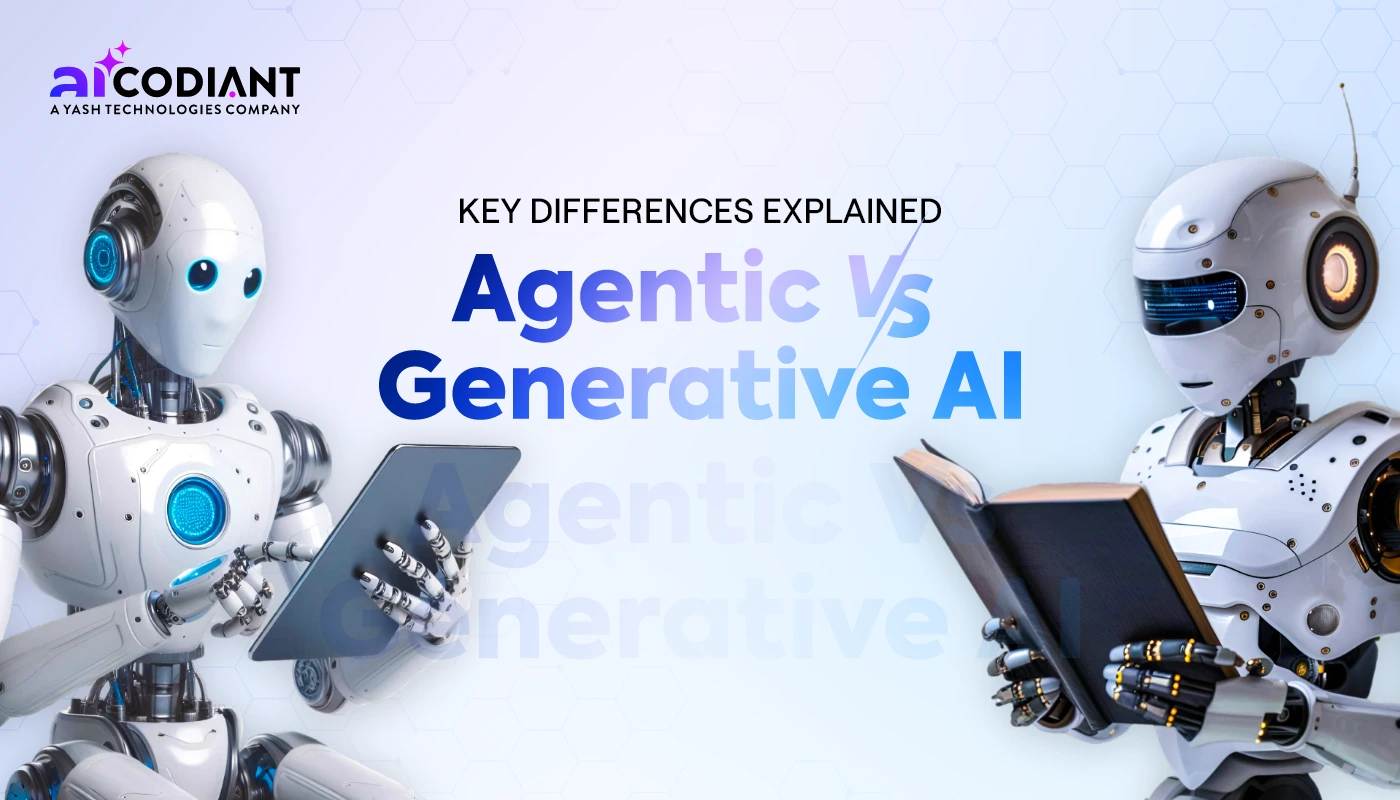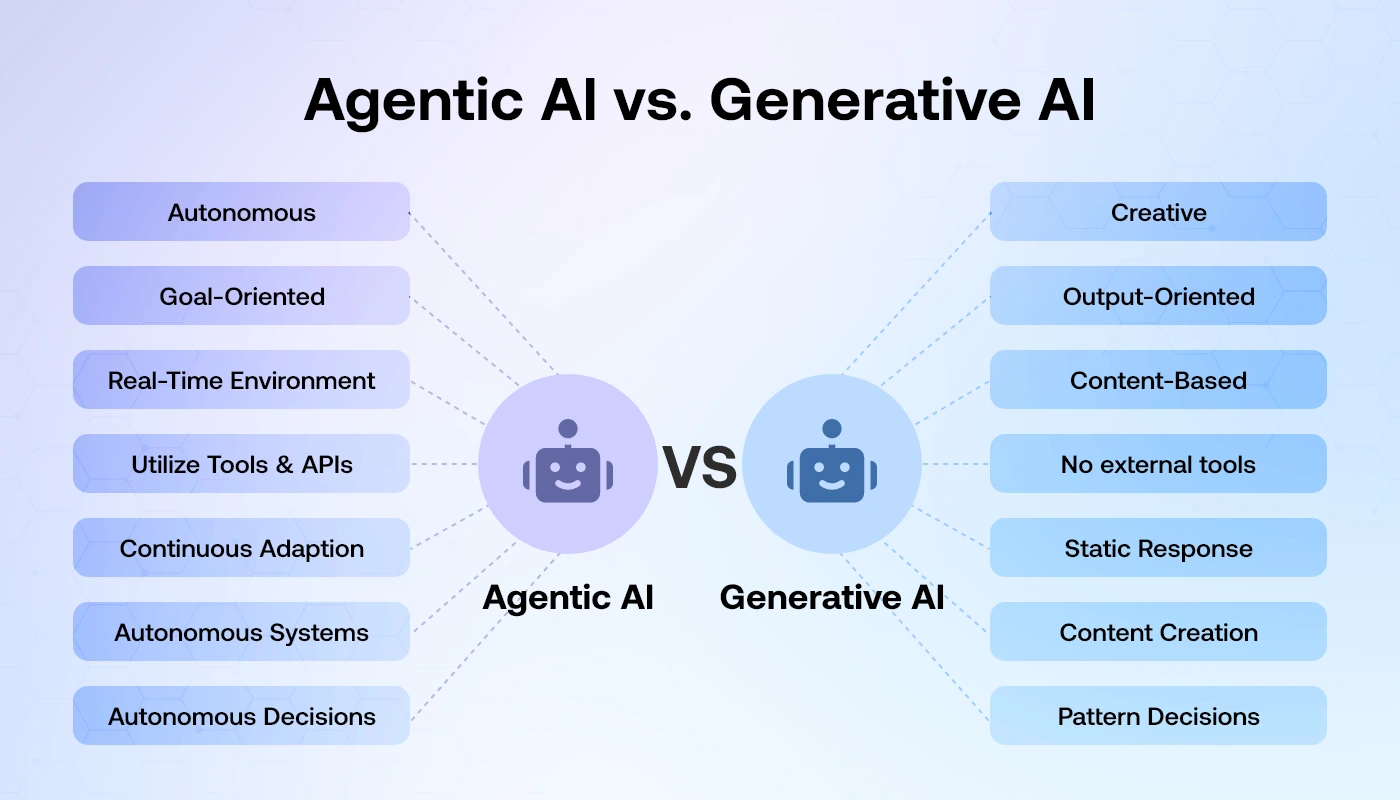Agentic vs Generative AI: What’s the key difference & Use Cases
Table of Contents
Subscribe To Our Newsletter

Just a few years ago AI was mainly about prediction and pattern recognition – helping us autocomplete texts, recommend movies or detect fraud. Then came Generative AI, and the world watched in awe as tools like ChatGPT wrote poems, DALL·E painted surreal landscapes and Midjourney reimagined our imagination. AI wasn’t just crunching numbers anymore – it was creating.
But now, in 2025 something even more transformative is unfolding.
Enter Agentic AI – a new wave of intelligent agents that don’t just generate content… they act. These AI agents can browse websites, book appointments, send emails and even manage workflows on your behalf – without being told every single step. Think of them as proactive digital teammates rather than passive assistants.
So, the question we’re now asking is: Are we moving from AI that simply creates… to AI that takes initiative and drives outcomes?
In this blog, we’ll break down the core difference between Generative and Agentic AI, explore where they overlap and explain why this shift matters more than ever for businesses and innovators in 2025.
What is Generative AI?
Generative AI refers to a class of artificial intelligence models designed to create new content – be it text, images, audio or even video – based on prompts given by a human. Think of it as a highly advanced assistant that can mimic creativity on command.
When you ask ChatGPT to draft an email or Midjourney to create a futuristic cityscape from a text description, you’re seeing Generative AI in action. Other popular tools in this space include Claude, Gemini and DALL·E – each capable of producing high-quality content in a matter of seconds.
Here’s what Generative AI can do:
- Write and edit content like blogs, scripts or summaries
- Translate text between languages
- Generate images based on text inputs
- Create voiceovers or music from cues
But here’s the catch – it’s reactive, not proactive. Generative AI doesn’t take initiative or make decisions on its own. It waits for your prompt, responds and then stops. While it’s brilliant at creating, it doesn’t have goals, memory of past actions or the ability to independently carry out tasks without being told what to do.
What is Agentic AI?
Agentic AI takes things a step further than Generative AI. Instead of waiting around for instructions, these systems are autonomous, proactive and goal-driven – they can think, plan and act on their own.
Imagine an AI that doesn’t just answer your questions, but also figures out what needs to be done, pulls the right data, uses tools or APIs and carries out a series of tasks – all without you constantly guiding it. That’s Agentic AI.
Tools like Auto-GPT, BabyAGI, Devin and modern AI co-pilots are great examples. These AI agents don’t just generate responses – they perceive their environment, reason through tasks, make decisions and take action to meet a goal.
Some of their standout traits include:
- Autonomous reasoning: They can decide what to do next
- Memory: They remember past steps and learn from outcomes
- Planning: They build and follow multi-step strategies
- Tool usage: They can interact with software, databases, or APIs
In other words, Agentic AI isn’t just helpful – it’s hands-on. It’s like giving your AI a job and watching it work toward a goal independently.
Agentic AI vs Generative AI – Key Differences
Firstly, Agentic AI and Generative AI are two distinct categories under the giant umbrella of artificial intelligence. One generates content if requested whereas the other behaves as if it is an artificial executive, reasoning, representing action plans and performing tasks autonomously. Here is a side-by-side comparison to give you an easier way to see how they stack up against each other:
| Feature | Generative AI | Agentic AI |
| Purpose | Creates content based on user prompts | Acts to complete tasks and achieve goals |
| Initiation | Waits for instructions | Takes action on its own |
| Autonomy | Passive and reactive | Autonomous and proactive |
| Examples | ChatGPT, Midjourney, Gemini, Claude | Auto-GPT, BabyAGI, Devin, AI co-pilots |
| Memory & Planning | Little to no memory or planning ability | Can remember steps, plan long-term, and adjust actions |
| Tool Usage | Limited to content generation | Can use tools, APIs, and databases to complete workflows |
| Best For | Content creation, summarization, translation | Automating multi-step tasks, decision-making, goal execution |
| User Involvement | Needs frequent prompts and guidance | Needs minimal input once a goal is set |
Can Agentic and Generative AI Work Together?

Yes – they can, and often they do.
In fact some of the most effective AIs in the world today are the result of hybridizing both. Imagine Generative AI as the creative engine that creates content, whereas Agentic AI is the strategic brain that figures out what to do, when and how.
So, an example would be an Agentic AI which chooses to send a follow-up email to a lead. Rather than crafting it from scratch, it calls up a Generative AI (ChatGPT for example) to write the email. Finally, the agent examine it modify if required & send it – no human involvement.
By working together:
- Agentic AI sets the goal and plans the steps
- Generative AI creates the content needed at each step
- The result is a smart self-directed system that gets things done
So yes, it’s not a rivalry – it’s a partnership. When used together Agentic and Generative AI unlock a whole new level of automation and intelligence.
Real-World Applications & Use Cases
Generative AI
- Canva – Magic Design
Canva uses Generative AI to help users create stunning visuals by simply typing what they want. Whether it’s a presentation, social post or flyer, the AI instantly generates a design based on your prompt. - HubSpot – Content Assistant
HubSpot’s own AI writing tool helps marketers draft blog posts, emails, and CTAs faster by generating copy directly inside the platform – saving hours of manual writing. - Adobe Firefly
Adobe introduced Firefly to let creatives generate images, textures and effects using just text. It’s bringing creative ideas to life in seconds. - Notion – AI Writing Assistant
Notion’s AI helps users summarize meeting notes, rewrite messy paragraphs, and generate ideas inside their workspace – boosting productivity for teams and solopreneurs alike.
Agentic AI
- Cognosys (Built on Auto-GPT)
Cognosys is an autonomous AI agent that can take a user-defined goal like “build a newsletter campaign” and carry it out end-to-end – planning, writing and executing tasks using APIs and browser actions. - Devin by Cognition
Devin is the world’s first AI software engineer. It can write code, fix bugs, test applications and deploy projects – all by reasoning and working like a junior developer. - Adept – ACT-1
Adept’s AI agent ACT-1 interacts with software like a human assistant. It can navigate tools like Salesforce or Google Sheets to complete tasks such as updating contacts or building reports. - Multion AI
Multion acts like a smart virtual browser agent. It can visit websites, click buttons, fill forms and book appointments – just like a human would.
Business Implications in 2025

Let’s face it—understanding the difference between Generative and Agentic AI is no longer optional for CIOs, CTOs, and product leaders. Agentic AI is the real game-changer for the industries like real estate, healthcare, etc. It’s not about writing content anymore—it’s about tools that think, plan, and act without waiting for instructions. That shift opens the door to serious business transformation.
In 2025, more platforms will be agentic by default. Your CRM might follow up with leads automatically. AI dev tools like Devin will build and ship code on their own. Internal systems will detect and resolve issues before your team even notices. This isn’t future hype—it’s already happening.
Now, here’s the catch: autonomy comes with risk. When AI makes decisions on its own, businesses need to be ready. Who’s responsible if something goes wrong? How do you monitor outcomes? What policies guide what agents can and can’t do?
To make the most of Agentic AI, organizations need more than just adoption—they need structure. Legal, product, security, and data teams must align early. Clear governance, oversight, and fallback mechanisms will be critical. Businesses that figure this out fast will lead the next wave of automation. The rest will be playing catch-up.
Final Thoughts
Agentic AI isn’t a future concept—it’s a present capability with real implications that covers the all major industries like logistics, insurance, retails, etc. For teams building digital products or managing complex operations, now is the moment to evaluate how autonomous AI agents can step in—not just to assist, but to operate.
This shift requires more than awareness. It calls for experimentation.
Look at your workflows. Where are decisions still manual? What repetitive tasks slow your team down? These are likely your entry points.
The companies that start integrating Agentic AI into core systems today won’t just move faster—they’ll rethink how work happens altogether.
Not every process needs an agent. But some do. And identifying them early could be the edge that defines your competitive future.
Ready to move beyond prompts and into performance?
Partner with our AI experts to identify high-impact use cases and build scalable, intelligent systems—designed for real-world outcomes.
Frequently Asked Questions
Generative AI creates content like text, images, or audio based on prompts. Agentic AI, on the other hand, can plan, make decisions, and take actions on its own to reach a goal.
Not by default. Generative AI tools like ChatGPT need prompts to work. But when combined with tools that help it plan and act (like APIs or agents), it can be part of an Agentic system.
It depends on how it’s built and monitored. Since it makes decisions, it’s important to set rules, limits, and have clear oversight to avoid errors or risks.
Some platforms are no-code or low-code, but setting up Agentic AI usually needs some level of technical knowledge—especially when it interacts with other tools or data systems.
Featured Blogs
Read our thoughts and insights on the latest tech and business trends
AI Implementation Strategy – A Practical Framework for Startups & Enterprises
- October 29, 2025
- Artificial Intelligence
Every business leader today has the same question on their mind - How do we make AI work for us-without wasting time, money or trust? The answer lies in having the right AI implementation strategy.... Read more
AI Agents in Healthcare: Driving Smarter, Faster, Better Care
- October 7, 2025
- AI Agent Development Healthcare
Healthcare has a lot of problems right now. There are too many patients, not enough doctors, and costs keep going up. Technology has tried to help, but most tools don’t really fix things. An online... Read more
AI-Powered Skin Diagnosis: The Hidden Power Behind Beauty E-Commerce
- September 19, 2025
- Artificial Intelligence
Shopping for skincare online has become a normal part of modern life. Customers today order moisturizers, serums & cleansers with just a few clicks. So far the digital shopping journey in beauty is still full... Read more




